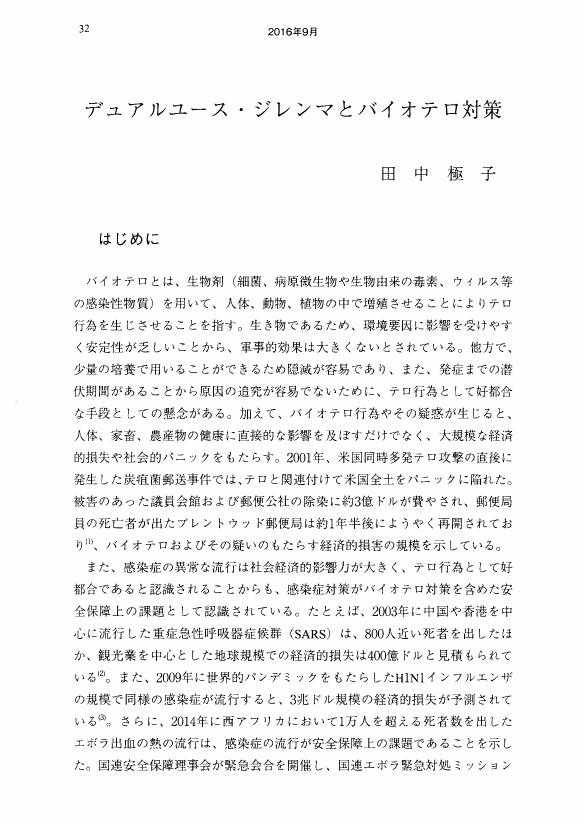2 0 0 0 OA 国際安全保障課題としての生物学的脅威とバイオセキュリティ
- 著者
- 田中 極子
- 出版者
- 国際基督教大学 International Christian University
- 雑誌
- 社会科学ジャーナル = The Journal of Social Science (ISSN:04542134)
- 巻号頁・発行日
- no.89, pp.139-164, 2022-03-31
The new coronavirus (COVID-19), which caused a global pandemic in 2020, continues to be disputed over its source, whether it is a natural outbreak or a laboratory spill.It is not an easy task to determine the source of an infectious disease outbreak: whether it is a natural outbreak, an accidental spill from a laboratory, or a deliberate criminal act. It is because of the characteristics of biological agents (infectious agents such as bacteria, pathogenic microorganisms and toxins of biological origin, or viruses) that can be used in small amounts in culture, which makes them easy to conceal, and by the fact that they have an incubation period before the onset of illness, which makes it difficult to track down the cause. Nonetheless, infectious disease outbreaks, once they occur regardless of the source, have a direct impact on people's lives and human health, cause socioeconomic panic and the scale of the damage is immeasurable.In addition, just as the response to COVID-19 caused confusion, the capability to contain the spread and mitigate damage after an outbreak occurs are limited. It is, therefore, an urgent task to build a national and global state of preparedness to control infectious disease, considering it as a non-traditional security agenda. United Nations Security Council Resolution 1540 is an attempt by the Security Council to tackle biological threats from an international security perspective. It was adopted in 2004 to prevent the proliferation of nuclear, chemical and biological weapons and their means of delivery to non-state 164 actors. One of the main obligations to all UN Member States is to adopt and implement appropriate national control measures to prevent the proliferation of related materials used to develop, produce or use for these weapons. According to the review of the national implementation of theresolution 1540, however, only half of the 193 UN member states have taken any measures on biosecurity, and there is a wide gap in the content of these measures.This issue may be due to the fact that there is no common understanding of "biosecurity" either within each country or internationally. This paper provides an overall picture of the biosecurity control by UN member states against current biological threats and identifies its challenges and prospects. The paper first illustrates an overview of the diversification of biological threats and depicts what “biosecurity” concepts are being developed accordingly. Four types of biological threats are described, namely, biological terrorism, global infectious disease pandemic, dual use research of concern and environmental risks in biodiversity. It then shows that different nations have different policy priorities for biological threats and that different “biosecurity” concepts are used based on such priorities through the review of national implementation of resolution 1540. The paper shows that many countries that have some national control measures for biological agents have secured such obligations under either infection control or environmental protection legal systems. The paper suggests that in order to establish a nationwidepreparedness system in the presence of different biological threats, countries need to have a standardized concept of "biosecurity" among policy domains and to view it as a public policy issue comprising all aspects of public health, security, economic, fiscal, as well as science and technology. To this end, the paper finally concludes that to effectively bridge the gap between different policy areas, establishing a forum for continuous information sharing is necessary.
1 0 0 0 OA デュアルユース・ジレンマとバイオテロ対策
- 著者
- 田中 極子
- 出版者
- 国際安全保障学会
- 雑誌
- 国際安全保障 (ISSN:13467573)
- 巻号頁・発行日
- vol.44, no.2, pp.32-49, 2016-09-30 (Released:2022-04-01)
1 0 0 0 OA バイオ脅威への対抗:生物兵器禁止条約の国内実施能力強化
- 著者
- 田中 極子
- 出版者
- The Society for Risk Analysis, Japan
- 雑誌
- 日本リスク研究学会誌 (ISSN:09155465)
- 巻号頁・発行日
- vol.21, no.3, pp.195-202, 2011 (Released:2012-03-27)
- 参考文献数
- 17
The H1N1 influenza pandemic and the foot-and-mouth epidemics, which both caused worldwide panic and economic disruption, are examples of infectious diseases that do not only directly harm human health, but also bring about social and economic turmoil. Given the possibility of such biological agents being used in acts of bio-terrorism, providing counter-measures against such threats in order to minimize social and economic damage is a major challenge for the modern world in creating an environment in which one can live without fear. Dealing with this challenge requires a full-scale global approach comprising all relevant actors not only in the public health sector, but also the public and private sectors of animal and plant epidemiology, security, law enforcement, as well as academia and industry. The Biological Weapons Convention (BWC) is also envisaged to play a role in countering biological threats. This article is to consider the ways to strengthen the effectiveness of the BWC with a view towards the coming 7th Review Conference of the BWC in December this year.
